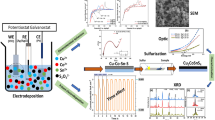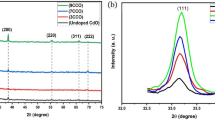Abstract
We report a study on the effects of O2/Ar ratio on the resistive switching properties of HfOx thin-films deposited by using RF magnetron sputtering. Ar is kept at a constant flow rate of 30 SCCM and O2 is varied from 0 to 30 SCCM during the deposition of these thin films. The UV–Vis spectra reveled that the transmission percentage of these films increase proportionally with increase of O2/Ar ratio up to a critical value. Further, the peak positions at 2.7 and 2.9 eV in PL spectra were attributed to singly and doubly charged oxygen vacancies respectively. These defects and vacancies alter the switching behavior of the devices. Moreover, the XPS data showed that the intensity of O–O bond peak decreases as O2/Ar ratio increases. Therefore, the switching performance shows a significant influence of the amount of inletting the oxygen gas with Ar during the deposition, thereby an improvement in the resistance ratio (Roff/Ron) of these HfOx based devices is noticed.











Similar content being viewed by others
Data availability
Data is available with authors and can be provided whenever required.
References
A. Chen, Solid-state electronics—a review of emerging non-volatile memory (NVM) technologies and applications. Solid State Electron. 125, 25–38 (2016). https://doi.org/10.1016/j.sse.2016.07.006
H. Yildirim, R. Pachter, Mechanistic analysis of oxygen vacancy-driven conductive filament formation in resistive random-access memory metal/NiO/metal structures. ACS Appl. Mater. Interfaces 10, 9802–9816 (2018). https://doi.org/10.1021/acsami.7b17645
W. Banerjee, Challenges and applications of emerging nonvolatile memory devices. Electronics 9(1029), 1–24 (2020). https://doi.org/10.3390/electronics9061029
L. Gao, Q. Ren, J. Sun, S.-T. Han, Y. Zhou, Memristor modeling: challenges in theories, simulations, and device variability. J. Mater. Chem. C 9, 16859–16884 (2021). https://doi.org/10.1039/d1tc04201g
M. Lanza, A review on resistive switching in high-k dielectrics: a nanoscale point of view using conductive atomic force microscope. Materials (Basel) 7(3), 2155–2182 (2014). https://doi.org/10.3390/ma7032155
D.B. Strukov, G.S. Snider, D.R. Stewart, R.S. Williams, The missing memristor found. Nature 453(7191), 80–83 (2008). https://doi.org/10.1038/nature06932
M. Pešić, U. Schroeder, S. Slesazeck, T. Mikolajick, T. Mikolajick, Reliability aspects of novel anti-ferroelectric non-volatile memories compared to hafnia based ferroelectric memories. IEEE Int. Integr. Reliab. Workshop (IIRW) (2017). https://doi.org/10.1109/IIRW.2017.8361237
T.S. Böscke, J. Müller, D. Bräuhaus, U. Schröder, U. Böttger, Ferroelectricity in hafnium oxide thin films. Appl. Phys. Lett. 99, 102903 (2011). https://doi.org/10.1063/1.3634052
K. Kim, Y.J. Song, Integration technology for ferroelectric memory devices. Microelectron. Reliab. 43(3), 385–398 (2003). https://doi.org/10.1016/S0026-2714(02)00285-8
W. Banerjee, A. Kashir, S. Kamba, Hafnium oxide (HfO2)—a multifunctional oxide: a review on the prospect and challenges of hafnium oxide in resistive switching and ferroelectric memories. Small 18(23), 2107575 (2022). https://doi.org/10.1002/smll.202107575
G. Mola, E. Nowak, Advances in emerging memory technologies: from data storage to artificial intelligence. Appl. Sci. 11, 11254 (2021)
F. Palumbo, Formation and characterization of filamentary current paths in HfO2-based resistive switching structures. IEEE Electron. Device Lett. 33(7), 1057–1059 (2012). https://doi.org/10.1109/LED.2012.2194689
D. Ielmini, Resistive switching memories based on metal oxides: mechanisms, reliability and scaling. Semicond. Sci. Technol. 31(6), 1–25 (2016). https://doi.org/10.1088/0268-1242/31/6/063002
A. Sawa, Resistive switching in rapid advances in information technology rely on high-speed and large-capacity nonvolatile memories. Mater. Today 11(6), 28–36 (2008). https://doi.org/10.1016/S1369-7021(08)70119
Q. Wang, G. Niu, S. Roy, Y. Wang, Y. Zhang, H. Wu, S. Zhai, W. Bai, P. Shi, S. Song, Z. Song, Interface-engineered reliable HfO2-based RRAM for synaptic simulation. J. Mater. Chem. C 7, 12682–12687 (2019). https://doi.org/10.1039/c9tc04880d
X. Lian, E. Miranda, S. Long, L. Perniola, M. Liu, J. Sune, Three state resistive switching in HfO2-based RRAM. Solid State Electron. 98, 38–44 (2014). https://doi.org/10.1016/j.sse.2014.04.016
N. Arun, K.V. Kumar, A.P. Pathak, D.K. Avasthi, S.V.S. Nageswara Rao, Hafnia-based resistive switching devices for nonvolatile memory applications and effects of gamma irradiation on device performance. Rad. Eff. Def. Sol. 173(3–4), 239–249 (2018). https://doi.org/10.1080/10420150.2018.1425863
N. Arun, L.D. Varma Sangani, K. Vinod Kumar, A. Mangababu, M. Ghanashyam Krishna, A.P. Pathak, S.V.S. Nageswara Rao, Effects of swift heavy ion irradiation on the performance of HfO2-based resistive random access memory devices. J. Mater. Sci.: Mater. Electron. 32, 2973–2986 (2021). https://doi.org/10.1007/s10854-020-05049-0
Y. Xiangxiang Ding, P. Feng, L. Huang, J.K. Liu, Low-power resistive switching characteristic in HfO2/TiOx Bi-layer resistive random-access memory. Nanoscale Res. Lett. (2019). https://doi.org/10.1186/s11671-019-2956-4
C. Muhammad Ismail, O. Mahata, S. Kim, Neuromorphic synapses with high switching uniformity and multilevel memory storage enabled through a Hf–Al–O alloy for artificial intelligence. ACS Appl. Electron. Mater. 4, 1288–1300 (2022). https://doi.org/10.1021/acsaelm.2c00023
C.-Y. Huang, W.C. Shen, Y.-H. Tseng, Y.-C. King, C.-J. Lin, IEEE Electron. Device Lett. 33, 1108–1110 (2012)
A. Chen, 2015 IEEE international electron devices meeting (IEDM), 2015
M.S. Rathore, A. Vinod, R. Angalakurthi, A.P. Pathak, S.K. Thatikond, S.R. Nelamarri, Role of oxygen pressure on the structural and photoluminescence properties of pulsed laser deposited GeO2 thin films. Phys. B: Phys. Condens. Matter. 625, 413466 (2022). https://doi.org/10.1016/j.physb.2021.413466
B. Biplab Sarkar, V. Misra, Understanding the gradual reset in Pt/Al2O3/Ni RRAM for synaptic applications. Semicond. Sci. Technol. 30(10), 105014 (2015). https://doi.org/10.1088/0268-1242/30/10/105014
K. Park, J.-S. Lee, Reliable resistive switching memory based on oxygen-vacancy-controlled bilayer structures. RSC Adv. 6, 21736–21741 (2016). https://doi.org/10.1039/C6RA00798H
H.Y. Jeong, Y.I. Kim, J.Y. Lee, S.-Y. Choi, A low-temperature-grown TiO2-based device for the flexible stacked RRAM application. Nanotechnology 21, 115203 (2010). https://doi.org/10.1088/0957-4484/21/11/115203
M.A. Na Xiao, B. Villena, S. Yuan, B. Chen, M. Wang, Y. Eliáš, F. Shi, X. Hui, A. Jing, K. Scheuermann, P.C. Tang, M. McIntyre, Resistive random access memory cells with a bilayer TiO2/SiOx insulating stack for simultaneous filamentary and distributed resistive switching. Adv. Funct. Mater. 27, 1700384 (2017). https://doi.org/10.1002/adfm.201700384
M.M. Rehman, H.M.M.U. Rehman, J.Z. Gul, W.Y. Kim, K.S. Karimov, N. Ahmed, Decade of 2D-materials-based RRAM devices: a review. Sci. Technol. Adv. Mater. 21(1), 147–186 (2020). https://doi.org/10.1080/14686996.2020.1730236
J.M. Khoshman, A. Khan, M.E. Kordesch, Amorphous hafnium oxide thin films for antireflection optical coatings. Surf. Coat. Technol. 202, 2500–2502 (2008). https://doi.org/10.1016/j.surfcoat.2007.07.095
J. Allan, J.A. Waldorf, T. Dobrowolski, B. Sullivan, L.M. Plante, Optical coatings deposited by reactive ion plating. Appl. Opt. 32, 5583–5593 (1993). https://doi.org/10.1364/AO.32.005583
S.U. Sharath, T. Bertaud, J. Kurian, E. Hildebrandt, C. Walczyk, P. Calka, P. Zaumseil, M. Sowinska, D. Walczyk, A. Gloskovskii, T. Schroeder, L. Alff, Towards forming-free resistive switching in oxygen engineered HfO2–x. Appl. Phys. Lett. 104, 063502 (2014). https://doi.org/10.1063/1.4864653
S.U. Sharath, S. Vogel, L. Molina-Luna, E. Hildebrandt, C. Wenger, J. Kurian, M. Duerrschnabel, T. Niermann, G. Niu, P. Calka, M. Lehmann, H.-J. Kleebe, T. Schroeder, L. Alff, Control of switching modes and conductance quantization in oxygen engineered HfOx based memristive devices. Adv. Funct. Mater. 27, 1700432 (2017). https://doi.org/10.1002/adfm.201700432
A. Nimmala, A.P. Pathak, M. Ghanashyam Krishna, M. Motapothula V.S.N.R. Sunkaranam, Radiation response of HfOx-based resistive random access memory (RRAM) devices. ACS Appl. Electron. Mater. 4(11), 5594–5601 (2022). https://doi.org/10.1021/acsaelm.2c01180
T. Torchynska, L.G. Vega Macotela, L. Khomenkova, F. Gourbilleau, L. Lartundo Rojas, Annealing impact on emission and phase varying of Nd-doped Si-rich-HfO2 films prepared by RF magnetron sputtering. J. Mater. Sci.: Mater. Electron. 31, 4587–4594 (2020). https://doi.org/10.1007/s10854-020-03010-9
O.J.Y. Federica Frati, M. Hunault, M.F. Frank, Oxygen K-edge X-ray absorption spectra. Chem. Rev. 120, 4056–4110 (2020). https://doi.org/10.1021/acs.chemrev.9b00439
M.-C. Chen, T.-C. Chang, S.-Y. Huang, G.-C. Chang, S.-C. Chen, H.-C. Huang, C.-W. Hu, S.M. Sze, T.-M. Tsai, D.-S. Gan, F.-S. Yeh, M.-J. Tsaif, Influence of oxygen partial pressure on resistance random access memory characteristics of indium gallium zinc oxide. Electrochem. Solid-State Lett. 14(12), H475–H477 (2011). https://doi.org/10.1149/2.007112esl
C.-L.L.C.-C. Tang, S.-C. Wu, P.-C. Juan, T.-K. Kang, Impact of oxygen composition of ZnO metal-oxide on unipolar resistive switching characteristics of Al/ZnO/Al resistive RAM (RRAM). Microelectron. Eng. 136, 15–21 (2015). https://doi.org/10.1016/j.mee.2015.03.027
S. Papernov, M.D. Brunsman, J.B. Oliver, B.N. Hoffman, A.A. Kozlov, S.G. Demos, A. Shvydky, F.H.M. Cavalcante, L. Yang, C.S. Menoni, B. Roshanzadeh, S.T.P. Boyd, L.A. Emmert, W. Rudolph, Optical properties of oxygen vacancies in HfO2 thin films studied by absorption and luminescence spectroscopy. Opt. Express 26(13), 17608–17623 (2018). https://doi.org/10.1364/OE.26.017608
M. Dhanunjaya, D.K. Avasthi, A.P. Pathak, S.A. Khan, S.V.S. Nageswara Rao, Grain fragmentation and phase transformations in hafnium oxide induced by swift heavy ion irradiation. Appl. Phys. A 124(587), 1–10 (2018). https://doi.org/10.1007/s00339-018-2000-z
H.W. ChenWang, B. Gao, T. Zhang, Y. Yang, H. Qian, Conduction mechanisms, dynamics and stability in ReRAMs. Microelectron. Eng. 187–188, 121–133 (2018). https://doi.org/10.1016/j.mee.2017.11.003
S. Gao, G. Liu, Q. Chen, Improving unipolar resistive switching uniformity with cone-shape conducting filaments and its logic-in-memory application. ACS Appl. Mater. Interfaces 10(7), 6453–6462 (2018). https://doi.org/10.1021/acsami.7b19586
S.H. Writam Banerjee, S. Kim, S. Lee, D. Lee, H. Hwang, Deep insight into steep-slope threshold switching with record selectivity (> 4×1010) controlled by metal-ion movement through vacancy-induced-percolation path: quantum-level control of hybrid-filament. Adv. Funct. Mater. 31, 1–9 (2021). https://doi.org/10.1002/adfm.202104054)
J.J. Desmond, P.A. Loy, S. Dananjaya, K.H. Chakrabarti, S.C.W. Tan, E.H. Chow, K. Toh, W.S. Lew, Oxygen vacancy density dependence with a hopping conduction mechanism in multilevel switching behavior of HfO2–based resistive random-access memory devices. ACS Appl. Electron. Mater. 2, 3160–3170 (2020). https://doi.org/10.1021/acsaelm.0c00515
H. Aziza, S. Hamdioui, M. Fieback, M. Taouil, M. Moreau, P. Girard, A. Virazel, K. Coulié, Multi-level control of Resistive RAM (RRAM) using a write termination to achieve 4 bits/cell in high resistance state. Electronics 10, 1–15 (2021). https://doi.org/10.3390/electronics10182222
D. Maldonado, S. Aldana, M.B. Gonzalez, F. Jimenez-Molinos, F. Campabadal, J.B. Roldan, Parameter extraction techniques for the analysis and modeling of resistive memories. Microelectron. Eng. 265, 111876 (2022). https://doi.org/10.1016/j.mee.2022.111876
G. Baek, M.S. Lee, S. Seo, M.J. Lee, D.H. Seo, D.S. Suh, J.C. Park, S.O. Park, H.S. Kim, I.K. Yoo, U. Chung, I.T. Moon, Highly, Scalable non-volatile resistive memory using simple binary oxide driven by asymmetric unipolar voltage pulses. IEDM (IEEE) 04, 587–890 (2004). https://doi.org/10.1109/IEDM.2004.1419228
Y. Mutsunori Uenuma, Y. Ishikawa, Joule heating effect in nonpolar and bipolar resistive random access memory. Appl. Phys. Lett. (2015). https://doi.org/10.1063/1.4928661
J. Héctor García, G. Boo, Ó.G. Vinuesa, S. Ossorio, H. Dueñas, M.B. Castán, F.C. González, Influences of the temperature on the electrical properties of HfO2-based resistive switching devices. Electronics 10, 2816 (2021). https://doi.org/10.3390/electronics10222816
X. Zhang, L. Xu, H. Zhang, J. Liu, D. Tan, L. Chen, Z. Ma, W. Li, Effect of Joule heating on resistive switching characteristic in AlOx cells made by thermal oxidation formation. Nanoscale Res. Lett. 15, 11 (2020). https://doi.org/10.1186/s11671-019-3229-y
Acknowledgements
N. Arun thanks UGC-NET for providing the fellowship (JRF and SRF) and National Academy of Sciences India (NASI) for RA. APP thanks NASI, India, Prayagraj (Allahabad) for the award of NASI Sr Scientist Platinum Jubilee Fellowship. We thank Centre for Nanotechnology (CFN), University of Hyderabad for providing necessary characterization facilities.
Funding
The project fund is granted from the National Academy of Sciences India (NASI), Prayagraj (Allahabad), India.
Author information
Authors and Affiliations
Contributions
NA: Methodology, Formal analysis, Data curation, Investigation, Validation, Writing—original draft, Writing—review & editing; APP: Conceptualization, Resources, Methodology, Writing—review & editing, Supervision, Funding acquisition, Project administration; VVRKK: Conceptualization, Methodology, Writing—review & editing; MMN: Data analysis and interpretation; SVSNR: Conceptualization, Resources, Methodology, Writing—review & editing, Supervision, Funding acquisition, Project administration.
Corresponding author
Ethics declarations
Competing interest
The authors declare that they have no known competing financial interests or personal relationships that could have appeared to influence the work reported in this paper. There is no conflict of interest.
Additional information
Publisher’s Note
Springer Nature remains neutral with regard to jurisdictional claims in published maps and institutional affiliations.
Rights and permissions
Springer Nature or its licensor (e.g. a society or other partner) holds exclusive rights to this article under a publishing agreement with the author(s) or other rightsholder(s); author self-archiving of the accepted manuscript version of this article is solely governed by the terms of such publishing agreement and applicable law.
About this article
Cite this article
Arun, N., Neethish, M.M., Ravi Kanth Kumar, V.V. et al. Resistive switching properties of hafnium oxide thin-films sputtered at different oxygen partial pressures. J Mater Sci: Mater Electron 35, 235 (2024). https://doi.org/10.1007/s10854-024-12023-7
Received:
Accepted:
Published:
DOI: https://doi.org/10.1007/s10854-024-12023-7




